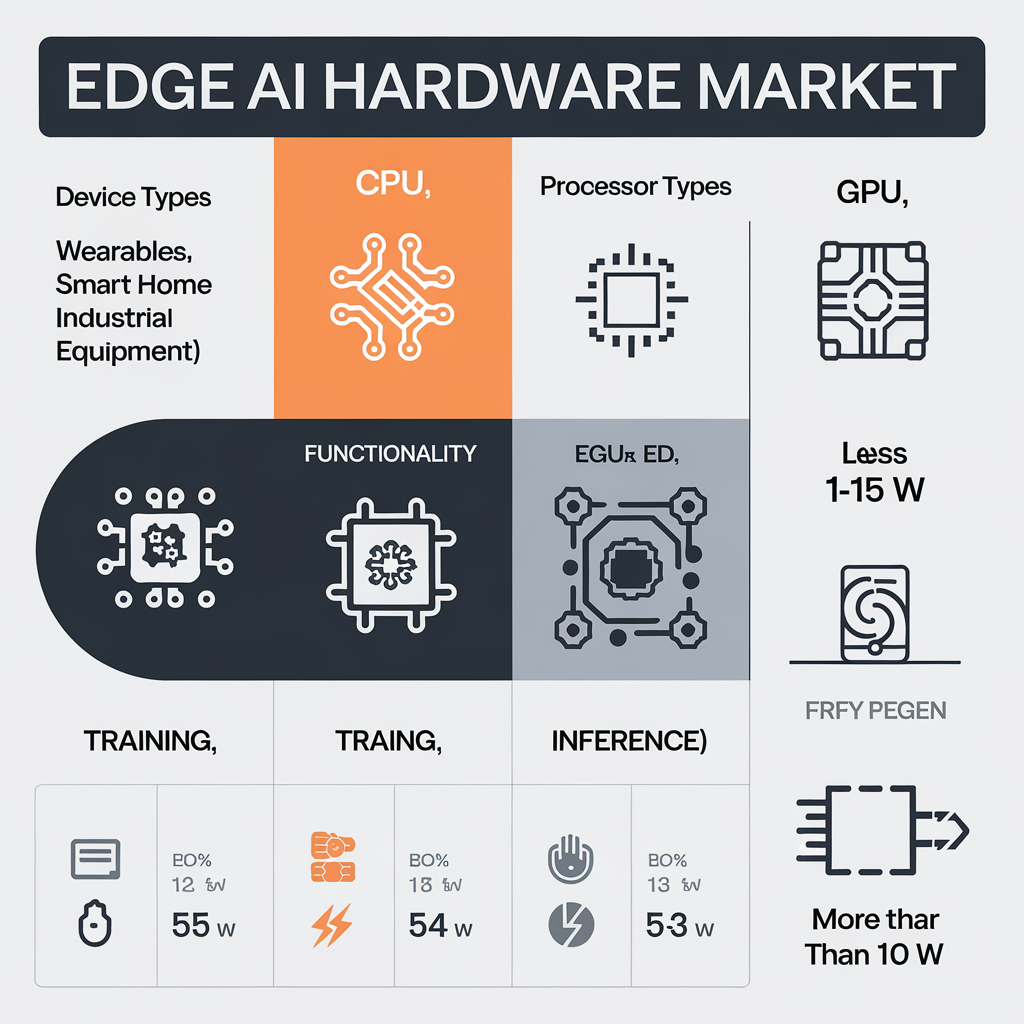The future of the Edge AI hardware industry looks promising as technological advancements continue to reshape the market. Edge AI hardware, which enables AI processing at the device level, has been gaining momentum across various industries. This article explores the major trends shaping the future of Edge AI hardware, market growth projections, leading companies in the industry, regional analysis, opportunities, challenges, and market segmentation.
Trends Shaping the Future of Edge AI Hardware Industry
- Increased Demand for Real-Time AI Processing: One of the most significant trends is the rising demand for real-time data processing on devices. This eliminates latency and enhances security and privacy. Industries such as healthcare, manufacturing, and autonomous vehicles are driving this demand for real-time decision-making capabilities on the edge.
- 5G Integration: The global rollout of 5G is expected to boost Edge AI hardware adoption, allowing for more efficient data transfer between edge devices and cloud platforms. With higher bandwidth and lower latency, 5G will empower edge devices to handle more complex AI tasks.
- Energy-Efficient AI Chips: The development of energy-efficient AI hardware is becoming a top priority. With environmental concerns and the need for longer battery life in IoT devices, companies are focusing on designing chips that consume less power without sacrificing performance.
- Adoption of AI Accelerators: AI accelerators, such as GPUs, FPGAs, and ASICs, are being integrated into edge devices to enhance computational power. These accelerators enable more sophisticated AI workloads, making edge AI hardware more versatile for diverse applications.

Edge AI Hardware Market Growth Projection
The Edge AI hardware market is projected to witness exponential growth over the next decade. According to industry estimates, the edge AI Hardware industry is projected to grow from USD 24.2 billion in 2024 and is expected to reach USD 54.7 billion by 2029, growing at a CAGR of 17.7% from 2024 to 2029. Key factors driving this growth include the increased use of AI in IoT devices, the deployment of 5G networks, and the demand for low-latency, high-efficiency AI solutions at the edge.
Top Companies in the Edge AI Hardware Industry
Several prominent players are leading the Edge AI hardware market with cutting-edge solutions. These companies are driving innovation and setting benchmarks in terms of performance and efficiency. Some of the top companies include:
- NVIDIA Corporation: Known for its powerful GPUs, NVIDIA is a leading player in the AI hardware market, providing solutions for edge computing across industries.
- Intel Corporation: Intel’s AI accelerators, including the Movidius Vision Processing Unit (VPU) and Neural Compute Stick, are widely used in edge devices.
- Qualcomm Technologies: Qualcomm’s Snapdragon chipsets are at the forefront of mobile edge AI, powering smartphones, IoT devices, and more.
- Google: With its Tensor Processing Unit (TPU), Google is a key player in the development of AI-specific hardware for edge computing.
- Xilinx: Specializing in FPGAs, Xilinx provides flexible AI solutions for various edge applications.
Regional Analysis of Edge AI Hardware Industry
The edge AI hardware market is growing rapidly across different regions, with North America leading the charge due to its advanced technological infrastructure and early adoption of AI. The presence of major tech companies, robust R&D activities, and the rapid deployment of 5G are key factors contributing to growth in this region.
Asia-Pacific is also emerging as a significant player, driven by countries like China, Japan, and South Korea. The region’s booming electronics industry, large-scale investments in AI, and government initiatives supporting AI development are pushing the demand for edge AI hardware.
Europe is witnessing steady growth, particularly in sectors such as automotive, healthcare, and manufacturing. The adoption of edge AI hardware in smart factories and autonomous vehicles is expected to drive future growth in the region.
Opportunities in the Edge AI Hardware Industry
The Edge AI hardware market offers several opportunities for innovation and growth:
- Expansion in Autonomous Vehicles: As the autonomous vehicle market grows, there will be an increasing need for powerful AI hardware to process real-time data from sensors and cameras, making edge AI crucial for safety and efficiency.
- IoT and Smart Devices: The integration of AI in IoT devices opens up significant opportunities in smart homes, healthcare wearables, industrial automation, and more. Edge AI hardware will play a central role in enabling these devices to process data efficiently.
- Healthcare and Medical Devices: AI-powered edge devices in healthcare, such as wearable monitors and diagnostic tools, will revolutionize the industry by offering real-time analysis and personalized care, further expanding the market.
- Security and Surveillance: With increasing concerns over data security and privacy, edge AI offers an opportunity to process sensitive data locally, reducing the risks of cloud-based storage and transmission.
Challenges Facing the Edge AI Hardware Industry
While the future looks bright, the Edge AI hardware industry faces several challenges:
- Power Consumption and Heat Dissipation: Managing power consumption and heat dissipation in AI hardware remains a critical issue, particularly for edge devices that need to operate efficiently in constrained environments.
- Cost of Implementation: Developing and deploying edge AI hardware can be costly, especially for smaller companies. High upfront costs and limited scalability are barriers to widespread adoption.
- Complexity in Software-Hardware Integration: Integrating AI software with edge hardware is still complex and requires specialized knowledge. Companies need to develop seamless ecosystems where AI models can be efficiently run on edge devices without compatibility issues.
- Data Privacy Regulations: With stricter regulations around data privacy and security (such as GDPR), companies need to ensure that edge AI hardware complies with legal standards, which can add to operational costs and complexity.
Edge AI Hardware Industry Segmentation
The Edge AI hardware industry can be segmented based on:
- Component: Processors (CPUs, GPUs, FPGAs, ASICs), memory, and sensors.
- Device Type: Smartphones, wearables, smart cameras, robots, and autonomous vehicles.
- End-Use Industry: Healthcare, manufacturing, automotive, consumer electronics, and retail.
- Region: North America, Europe, Asia-Pacific, Latin America, and the Middle East & Africa.
The Edge AI hardware industry is on the cusp of a significant transformation, driven by technological advancements and increasing demand for intelligent, real-time data processing. With growth opportunities across various sectors, the future of this industry looks promising. However, challenges such as power efficiency, cost, and complexity in integration need to be addressed to unlock the full potential of edge AI hardware. As the market continues to evolve, companies that can innovate and overcome these challenges will lead the way in shaping the future of this dynamic industry.
24World Media does not take any responsibility of the information you see on this page. The content this page contains is from independent third-party content provider. If you have any concerns regarding the content, please free to write us here: contact@24worldmedia.com

